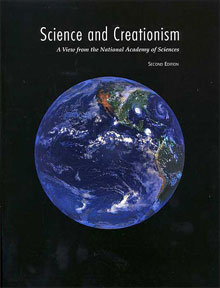Book Notes
 Science and Creationism: A View From the National Academy of Sciences, second edition, (Washington, DC: National Academies Press, 1999, 2002), 35pp.
Science and Creationism: A View From the National Academy of Sciences, second edition, (Washington, DC: National Academies Press, 1999, 2002), 35pp.
In 1987 the Supreme Court ruled that creationism is a religious belief and not science, and therefore it could not be taught in public schools that are required to be religiously neutral. Nevertheless, in a recent article in the New York Times ("Opting Out in the Debate on Evolution," June 21, 2005), current controversies in Kansas and Pennsylvania indicate that the issue refuses to go away. In the Kansas case, the school board decided to "teach the controversy," whereas the point of the article was that since mainstream science is so convinced of the overwhelming evidence for evolution that they don't even acknowledge a controversy, scientists refused to participate when asked to testify.
The present booklet, along with its longer companion book Teaching About Evolution and the Nature of Science (1998), presents the best efforts of the National Academy of Sciences to give an overview of mainstream science's views about evolution in general and "creation science" (and intelligent design) in particular. Negatively, the booklet argues that creation science is not a science because it cannot claim empirical evidence and is not testable. It should therefore not be taught in science classes, although, presumably, it might be taught in a comparative religions or similar humanities class. Positively, the booklet summarizes the evidence for evolution in three areas—the origins of the universe, earth, and life itself; biological evolution as evidenced in the five areas of paleontology, comparative anatomy, biogeography, embryology, and molecular biology; and then human evolution. At the end of each of these sections very brief considerations of creationism's views on these subjects are summarized and dismissed.
This report makes several important caveats, concessions or qualifications regarding the scientific enterprise. First, it acknowledges that science is not the only way of knowing. A worldview without broader knowledge beyond science would be deeply impoverished. Second, it affirms that many scientists are deeply religious and "hold that God created the universe and the various processes driving physical and biological evolution," a simple statement of fact that often goes unnoticed. Third, it reminds the reader that many religious people see no conflict with evolution. In fact, the report concedes that theistic evolution "is not in disagreement with scientific explanations of evolution." That would imply, for example, that science need not be materialistic or atheistic, even though its purview is the merely material. Fourth, for its part, because its scope is so very narrow, science "cannot comment on the role that supernatural forces might play in human affairs." That is, it must remain agnostic about areas outside of its empirical method. Fifth, the report seems to embrace a view similar to Stephen Gould's "non-overlapping magisteria," when it advocates that "science and religion occupy two separate realms." Thus, questions of morality, aesthetics, philosophy, politics, economics, social policy, and the like "extend beyond science's realm." In practice this is hardly ever true; scientists can and do comment on these issues, and when they do the mantle of prestige and authority that often attaches itself to science accompanies their opinions that, strictly speaking, lie outside of the scientific method. Do scientists really remain silent on the social, medical, economic, or moral implications of stem cell research, for example, or whether or when we might use the nuclear weapons science created? Finally, in several places the report notes that in science no truth is ever final, in the sense that scientific conclusions always remain open to correction and revision.
Note that this booklet is available online at www.nap.edu. A PDF version is also available for use with Adobe Acrobat.


